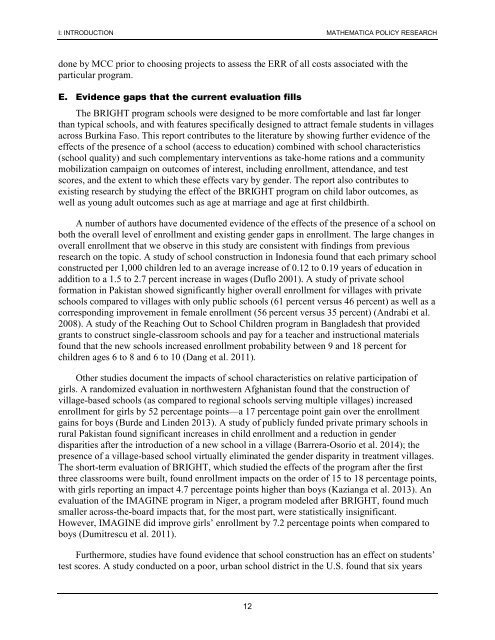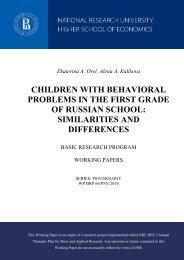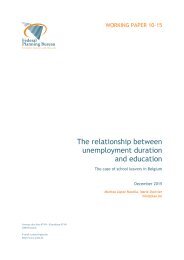Ten-Year Impacts of Burkina Faso’s BRIGHT Program
n?u=RePEc:mpr:mprres:2ecdd42bb503422b802ce20da2bf64b7&r=edu
n?u=RePEc:mpr:mprres:2ecdd42bb503422b802ce20da2bf64b7&r=edu
You also want an ePaper? Increase the reach of your titles
YUMPU automatically turns print PDFs into web optimized ePapers that Google loves.
I: INTRODUCTION MATHEMATICA POLICY RESEARCH<br />
done by MCC prior to choosing projects to assess the ERR <strong>of</strong> all costs associated with the<br />
particular program.<br />
E. Evidence gaps that the current evaluation fills<br />
The <strong>BRIGHT</strong> program schools were designed to be more comfortable and last far longer<br />
than typical schools, and with features specifically designed to attract female students in villages<br />
across <strong>Burkina</strong> Faso. This report contributes to the literature by showing further evidence <strong>of</strong> the<br />
effects <strong>of</strong> the presence <strong>of</strong> a school (access to education) combined with school characteristics<br />
(school quality) and such complementary interventions as take-home rations and a community<br />
mobilization campaign on outcomes <strong>of</strong> interest, including enrollment, attendance, and test<br />
scores, and the extent to which these effects vary by gender. The report also contributes to<br />
existing research by studying the effect <strong>of</strong> the <strong>BRIGHT</strong> program on child labor outcomes, as<br />
well as young adult outcomes such as age at marriage and age at first childbirth.<br />
A number <strong>of</strong> authors have documented evidence <strong>of</strong> the effects <strong>of</strong> the presence <strong>of</strong> a school on<br />
both the overall level <strong>of</strong> enrollment and existing gender gaps in enrollment. The large changes in<br />
overall enrollment that we observe in this study are consistent with findings from previous<br />
research on the topic. A study <strong>of</strong> school construction in Indonesia found that each primary school<br />
constructed per 1,000 children led to an average increase <strong>of</strong> 0.12 to 0.19 years <strong>of</strong> education in<br />
addition to a 1.5 to 2.7 percent increase in wages (Duflo 2001). A study <strong>of</strong> private school<br />
formation in Pakistan showed significantly higher overall enrollment for villages with private<br />
schools compared to villages with only public schools (61 percent versus 46 percent) as well as a<br />
corresponding improvement in female enrollment (56 percent versus 35 percent) (Andrabi et al.<br />
2008). A study <strong>of</strong> the Reaching Out to School Children program in Bangladesh that provided<br />
grants to construct single-classroom schools and pay for a teacher and instructional materials<br />
found that the new schools increased enrollment probability between 9 and 18 percent for<br />
children ages 6 to 8 and 6 to 10 (Dang et al. 2011).<br />
Other studies document the impacts <strong>of</strong> school characteristics on relative participation <strong>of</strong><br />
girls. A randomized evaluation in northwestern Afghanistan found that the construction <strong>of</strong><br />
village-based schools (as compared to regional schools serving multiple villages) increased<br />
enrollment for girls by 52 percentage points—a 17 percentage point gain over the enrollment<br />
gains for boys (Burde and Linden 2013). A study <strong>of</strong> publicly funded private primary schools in<br />
rural Pakistan found significant increases in child enrollment and a reduction in gender<br />
disparities after the introduction <strong>of</strong> a new school in a village (Barrera-Osorio et al. 2014); the<br />
presence <strong>of</strong> a village-based school virtually eliminated the gender disparity in treatment villages.<br />
The short-term evaluation <strong>of</strong> <strong>BRIGHT</strong>, which studied the effects <strong>of</strong> the program after the first<br />
three classrooms were built, found enrollment impacts on the order <strong>of</strong> 15 to 18 percentage points,<br />
with girls reporting an impact 4.7 percentage points higher than boys (Kazianga et al. 2013). An<br />
evaluation <strong>of</strong> the IMAGINE program in Niger, a program modeled after <strong>BRIGHT</strong>, found much<br />
smaller across-the-board impacts that, for the most part, were statistically insignificant.<br />
However, IMAGINE did improve girls’ enrollment by 7.2 percentage points when compared to<br />
boys (Dumitrescu et al. 2011).<br />
Furthermore, studies have found evidence that school construction has an effect on students’<br />
test scores. A study conducted on a poor, urban school district in the U.S. found that six years<br />
12







